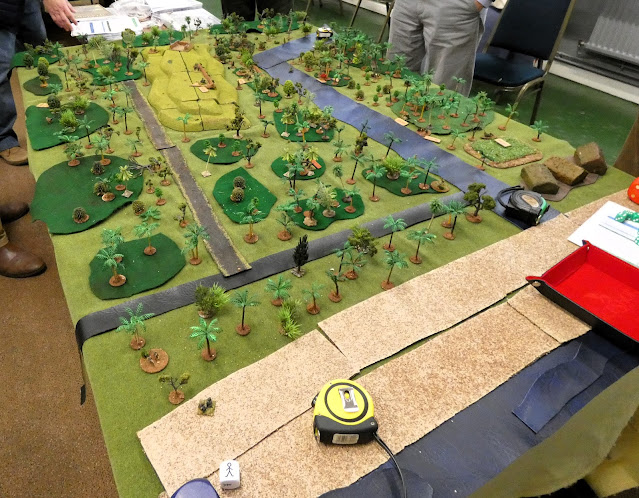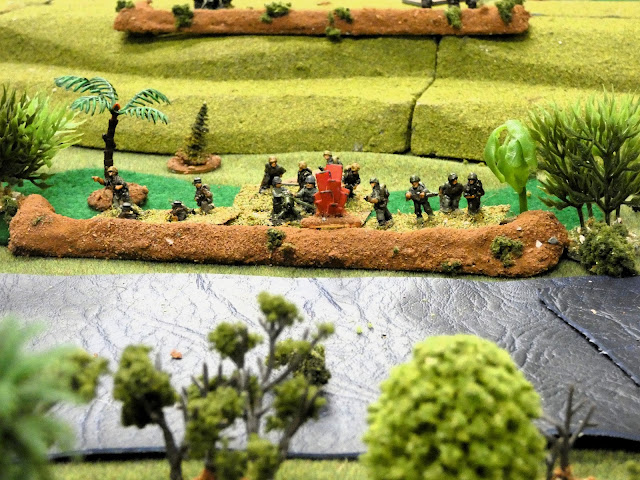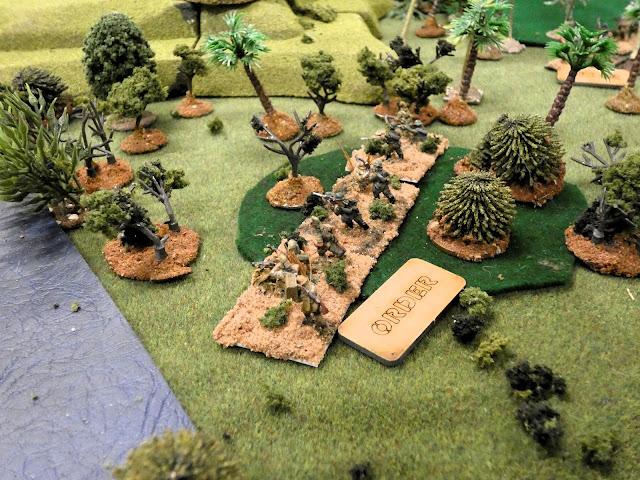We used Chain of Command by Two Fat Lardies, with the Vietnam and French Indochina supplements by Jason Sendjirdjian, see link below:
Six Command dice, one of which is red and counts for 1,2,3 & 4 only. All troops are elite.
have no deployment bonus and move as difficult terrain. French troops are motivated and well equipped, the rules limiting hand grenades to not apply. Commandos will not surrender.
Gian Khau village is identified as a Viet Minh logistic and training hub. Gian Khau cannot be attacked by land due to the poor roads and many ambush positions. A paradrop was considered and rejected because extraction will be by via same roads. The newly formed Dinassaut forces have been allocated this task.
You will attack just before first light, taking advantage of the river mist to approach (visibility is limited to 10 inches at least to start with). The village is lightly held by local defence troops but recent aerial reconnaissance has been hotly engaged by ground machine gun fire; three possible locations for these guns have been identified; two emplacements on the riverbank and one on the jetty. The best place to land is probably alongside the jetty, but the river is wadable to a certain extent (counts as heavy terrain). You can expect enemy reinforcements to arrive quite quickly, as this is an enemy training area too.
A recent photo-recon image is enclosed showing Gian Khau and jetty, possible machine gun positions and the roads leading to the nearby training camp.
Your objective is to destroy all the building and transport which are filled with supplies. Then make an expeditious exit the same way you arrived. Buildings are of light weight construction and can be easily demolished by gun, mortars or by engineers.
Viet Minh Order of Battle and Briefing
Five Command dice, most units count as regulars.
Gian Khau Village Garrison
- Snr Leader pistol (no grenades)
- 2 i/c Snr Leader, SMG (no grenades)
- Commissar & two runners
- 1 squad of 6 rifles (no grenades) Green Troops
- Support Weapons, Regular, 2 x MMG in sand bagged positions, with crew of 6 each
Gian Khau Main Force Training Camp.
- Company HQ
- 1 superior Snr Ldr, pistol (no grenades).
- 2 commissars, pistol with two runners each (no grenades).
Platoon
- Snr Leader, SMG (no grenades).
- 2 i/c Snr Ldr, SMG (no grenades).
4 rifle squads each consisting of:
- 1 Jnr leader with rifle and
- 9 riflemen (no grenades)
Viet Minh Briefing and Objectives.
The Deuxieme Bureau in Hanoi has released part of a speech by a senior commissar who visiting
Gian Khau; it is all you need to know:
“Comrades of Gian Khau village, by your efforts the day of liberation draws ever nearer. Daily you unload motivated comrades, weapons and rice, the three wants of the peoples’ struggle. After a dangerous transit, often from far away, these three wants are delivered for your safekeeping. By day you labour and by night you guard the three wants vigilantly. Even though Gian Khau is far from our beloved leader, your unceasing struggle does not pass unnoticed.”
Your objective is to defend the village buildings and lorry-park, where these important stores are kept. But first, you must mark the positions of your two machine guns and the entry route of the Main-Force reinforcements, on the aerial photograph recently acquired by one of our comrades working in the Deuxieme Bureau, Hanoi.
How the Game Played
Before the game started the Viet Minh (VM) player, had a couple of decisions to make; the location of two machine guns and where the Main Force reinforcements would enter. With his map now annotated the first set of six command dice were rolled by the elite French Commandos, commanded by Lawrence and Tom.
The French split their forces into two almost even groups and stormed ashore from the river, rather than land at the jetty. During the first turn the range was limited to ten inches, but despite being sufficient for the two machine gun positions to see the landing, the VM held their fire.
As the French consolidated their landing position, by bringing on more of their force, the VM deployed their village defence force, a small and poorly armed body of village folk, but well-motivated by their leader and supporting commissar. With the village force deployed the two VM machine guns opened-up, one in a sand bagged position and the other at the end of the jetty, killing two French commandos but ineffective against the monitor.
Luck now favoured the French with a double phase and they poured a huge return fire of sub machine gun, grenades all supported by the monitor’s machine guns and 37mm gun fire too; the VM gun crew were soon reduced to one.
Lady luck now gave the VM a double turn. The VM realising that they would never out gun the French, used the tactic of “grasping the enemy by the belt buckle” and surged forward towards the nearest group of commandos and into melee. The village VM group never got to roll their second phase; the melee saw their whole force destroyed and village morale collapse to zero. In one sweep the village defence had been overrun by the French but not without cost as four more French commandos had been killed in the desperate hand to hand fighting; something the French force could ill afford.
The sound of the fighting in the village had alerted the VM main force troops at the training camp, who now started to appear at their pre-designated jump off point (B). Equally as poorly equipped and equally as highly motivated as the village defenders, the VM Main Force were determined to see off their oppressors.
The French demolition teams wasted no time in moving though the village destroying buildings and supplies. The monitor crew joined in the process using gun and mortar fire to destroy further buildings. The commandos meanwhile spread out into the paddy fields behind the village, taking up positions behind the field bunds. And to bring their superior firepower to bear, the French used their chain of command dice to end the turn, which increased visibility to 15”.

With increased visibility some fire was exchanged but with little effect, one side or the other would have to close the range to achieve anything decisive. Knowing that their firepower was distinctly inferior to the French, the VM accepted that it would have to be them. Skilfully using the poor visibility to avoid being caught in too much cross fire, the VM entered the paddy fields making use of the bunds for cover, while concentrating their attention on the weaker of the two French groups. Awaiting the right moment a commissars leapt to his feet, grasped the flag and as the bugle sounded the charge he fell-over as he crossed the bund and splashed into the paddy (that is to say - the VM rolled a one on their movement dice!).
Fortunately, the hail of French fire only caused one VM casualty; perhaps the commissar was not that inspiring after all? On the second attempt the VM poured over the bund and meleed the French commandos. The result was predictably a brave loss by the VM, who lost all their men, except for the commissar and the senior leader, both last seen skedaddling-back the way they had come. But the French suffered two killed and the squad Sou-Seargent wounded as well; fortunately for both sides the morale effects were not very severe. The French, realising that they need more visibility to bring their superior firepower to bear, ended the turn so increasing the range to 20 inches.
The French and VM had fought each other to a standstill on one flank but on the other the French, meeting little resistance had made good progress. All the stores and building in the village had been destroyed as they pressed deeper into VM territory to blow-up and last storage area.
The senior sergeant had established his men and the company support machine gun, in the paddy fields where they engaged fleeting VM targets, though with little effect. He had hatched a plan whereby the engineers would outflank the VM positions through a burnt-out wood, supported by suppressive fire from his men and the mortar on the monitor; sadly things quickly went pear-shaped. There was a breakdown in walky-talky communication with the monitor as the supporting mortar fire went everywhere, except on target.

The VM senior leader quickly deducing the French plan and used his chain of command dice to move his jump off point, so he could more effectively deploy his remaining reserves. A clash ensued between the engineer team and a squad of approaching VM riflemen. While there were no casualties to either side, the French realising they were outnumbered retreated from the hill, pausing long enough to point out the approaching VM to the senior sergeant. This was just as well because the senior-sergeant had just enough time to rearrange his defences before the VM charged down-hill to melee his men.
As in previous melees the French superiority in fire power carried the day, killing every single VM, but not before three commandos were killed, including the senior-sergeant. This time the morale dice rolls were not so kind the VM and their steadily declining morale collapsed and the remaining VM force quitting the field.
Conclusion? While the French had carried the day and destroyed considerable amounts of VM stores, they had taken heavy casualties amongst the highly trained commandos. With the village and surrounding areas now secured, the French would demolish the reminder of the VM buildings and stores.
For the VM, the decision to melee the French were ever possible, would always result in heavy casualties but with inferior firepower it was probably the best decision. While the precious stores were lost, both the VM main-force senior leaders and commissars had all survived; the VM could rebuild their force and the struggle continue.
Acknowledgement
Most of the information used to construct this scenario comes from “Mourier pour L’Indochine – Wargaming French Indochina 1946-54”, by Shawn Taylor. While these are not the rules used to play the game today, they are a set that I will try to use in further games at the DWG, especially as they allow for larger scale deployments than do Chain of Command.
Thanks to Tom, Paul and Lawrence for playing the game, especially as VM Paul managed to keep an inscrutable poker face throughout. Figures are Empress Miniatures alongside several Warlord Games and Rubicon Miniatures plastic sets that I have “kit-bashed”, plus US troops I purchased second-hand but don’t know the manufacturer. Apologies for some of the French riverine fleet. Perhaps, since the vessels are more representative than involved, I should get these models in 15mm so the table would be less cluttered.
Stephen Huntsman
29 1 2024
.jpg)









































































